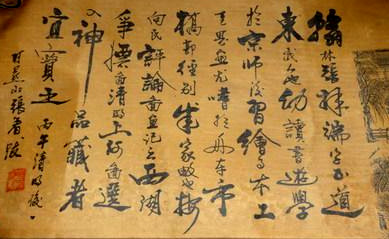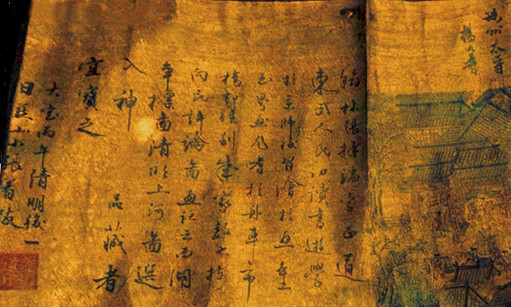Colophon of the painting
The colophon of the present copy is the following:
 |
This is not the original colophon by Zhang Zhu, but one of 13 colophons added later at the end of the scroll (see Zhang et al.1 for information on the other colophons). The present colophon is a poem by 酈權 (Lì Quán), a scholar working as official for the Jin dynasty in Henan prefecture2. The poem reads as follows1 :
峨峨城闕舊梁都,二十通門五漕渠。
何事東南最闐溢,江淮財利走舟車。
車轂人肩困擊磨,珠簾十里沸笙歌。
而今遺老空垂涕,猶恨宣和與政和。 (宋之奢靡 至宣政 間尤甚。)
京師得複比豐沛,根本之謀度漢高。
不念遠方民力病,都門花石日千艘。(大定丙午清明午一日張著跋於燕山月畔)。
The characters in brackets on the last line (translated below) are confusing, as they mention that Zhang Zhu is the author of the colophon. The date is 丙午, the year of the Fire Horse in the sexagesimal cycle, or 1186.
Below are images of the colophon found on internet. The text and the calligraphy are different from ours. All three have the same text (the original colophon by Zhang Zhu), but the calligraphy on the rightmost image is different from that of the others (and of ours).
|
|
|
The colophon reads as follows:
翰林张择端,字正道,
东武(山东诸城)人也。幼读书,游学
于京师,后习绘画,本工
其界画,尤嗜于舟车、市
桥、郭径,别成家数也。按
向氏《评论图画记》云:“《西湖
争标图》、《清明上河图》选
入神品,藏者
宜宝之。
大定丙午清明后一
日,燕山张著跋。
It has been translated by Yale professor Valerie Hansen3 as :
Hanlin Zhang Zeduan, styled Zhengdao, is a native of Dongwu [now Zhucheng, Shandong]. When young, he studied and traveled to the capital for further study. Later he practiced painting things. He showed talent for ruled-line painting, and especially liked boats and carts, markets and bridges, moats and paths. He was an expert in other types of paintings as well.
According to 'A Record of Mr Xiang's Views on Paintings,' Regatta on the Western Lake (Xihu zhengbiao tu) and Peace Reigns Over the River (Qingming shanghe tu) are placed in the category of inspired paintings. The owner should treasure it.
On the day after the Qingming festival, in 1186, Zhang Zhu from Yanshan wrote this colophon.
The other colophons and the names of their authors are listed in ZHANG Zhu et al.1.
There may be differences between the transcribed characters and the ones on the images, either because the latter are semantic variants of the same concept (for example the first two characters of the poem), or because the author of the copy did not faithfully write the original text.
Bibliography
1. ZHANG Zhu, ZHANG Gong-Yao, LI Quan, WANG Jian, ZHANG Shi-Ji, YANG Zhun, LIU Han, LI Qi, WU Kuan, LI Dong-Yang, LU Wan, FENG Bao, and RU Shou. Colophons of the painting: ZHANG Zeduan: Riversides of the Qingming. National History, 1 (6), nh20080611a2 (2008). | doi: 10.3128/nh20080611a2↩
available at : http://www.360doc.com/content/12/0330/12/9305059_199242287.shtml (retreived July 21, 2017)
2. Shiu-Lan (Jully) Huang, Wei-Chao Chang, Along the river during the Qingming festival. Cosmos Classics, 2016, p.24.
↩
https://books.google.fr/books?id=dcykDQAAQBAJ
3. Valerie Hansen, The mystery of the Qingming scroll and its subject: the case against Kaifeng. Journal of Sung-Yuan Studies, 26, 1996, pp.183-200.↩
http://history.yale.edu/sites/default/files/files/hansen-qingming-scroll(2).pdf"



